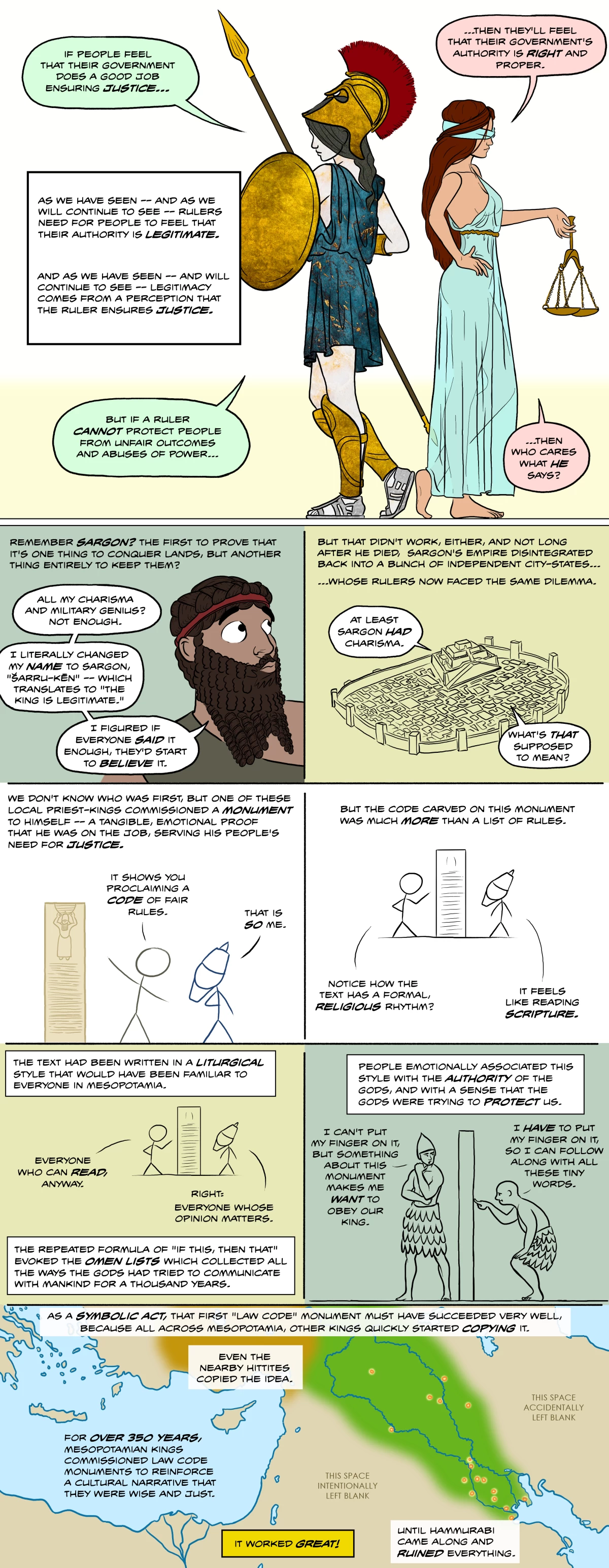
.
Oh dear. What’s Hammurabi gone and done this time.
Constitutional Law
Part 2: “What Were They Thinking?”
Digression: “A History of Government in 6 Revolutions: From the Paleolithic to Philadelphia”
104. What Law Codes Were For
Panel 1: The State and Lady Justice stand back-to-back. The State, a living marble statue, wears a bronze Corinthian helmet with a red plume, a tunic of blue-and-gold marble, bronze greaves, stone sandals, and is carrying a spear and shield of bronze. Lady Justice wears a pale blue blindfold and matching gown, and suspended from one hand are her scales of justice.
NARRATION: As we have seen—and as we will continue to see—rulers need for people to feel that their authority is legitimate. And as we have seen—and will continue to see—legitimacy comes from a perception that the ruler ensures justice.
THE STATE:
If people feel that their government does a good job ensuring justice…
LADY JUSTICE:
…then they’ll feel that their government’s authority is right and proper.
THE STATE:
But if a ruler cannot protect people from unfair outcomes and abuses of power…
LADY JUSTICE:
…then who cares what he says?
-=-
Panel 2: Sargon the Great, a/k/a Sargon of Akkad.
NARRATION: Remember Sargon? The first to prove that it’s one thing to conquer lands, but another thing entirely to keep them?
SARGON:
All my charisma and military genius? Not enough.
I literally changed my name to Sargon, “Šarru-kēn”—which translates to “the kind is legitimate.”
I figured if everyone said it enough, they’d start to believe it.
-=-
Panel 3: An ancient Mesopotamian city-state, with a great ziggurat temple and a fortified wall.
NARRATION: But that didn’t work, either, and not long after he died, Sargon’s empire disintegrated back into a bunch of independent city-states… …whose rulers now faced the same dilemma.
VOICE 1: At least Sargon had charisma.
VOICE 2: What’s that supposed to mean?
-=-
Panel 4: Stick figures of two ancient Mesopotamians, one a regular person, the other a king with royal headwear and beard. The regular person is showing a stele to the king.
NARRATION: We don’t know who was first, but one of these local priest-kings commissioned a monument to himself—a tangible, emotional proof that he was on the job, serving his people’s need for justice.
MAN:
It shows you proclaiming a code of fair rules.
KING:
That is so me.
-=-
Panel 5: The stick figures contemplate the words carved on the stele.
NARRATION: But the code carved on this monument was much more than a list of rules.
MAN:
Notice how the text has a formal, religious rhythm?
KING:
It feels like reading scripture.
-=-
Panel 6: The stick figures continue to discuss the stele.
NARRATION: The text had been written in a liturgical style that would have been familiar to everyone in Mesopotamia.
MAN:
Everyone who can read, anyway.
KING:
Right: Everyone whose opinion matters.
-=-
Panel 7: Two Mesopotamian men in tufted skirts by a law-code stele. One wears a helmet, the other’s bald head is bare. The bareheaded man is crouching to press his finger against the stele.
NARRATION: People emotionally associated this style with the authority of the gods, and with a sense that the gods were trying to protect us.
HELMET MAN:
I can’t put my finger on it, but something about this monument makes me want to obey our king.
BAREHEADED MAN:
I have to put my finger on it, so I can follow along with all these tiny words.
-=-
Panel 8: A map of the eastern Mediterranean and part of the Middle East, with coastlines as they existed in the early Bronze Age. The land of the Hittites is in brown. The land of Mesopotamian culture is in green, with orange dots showing the location of its city-states. The land to the south of Mesopotamia is marked “THIS SPACE INTENTIONALLY LEFT BLANK,” and the land to the east of Mesopotamia is marked “THIS SPACE ACCIDENTALLY LEFT BLANK.”
NARRATION:
As a symbolic act, that first “law code” monument must have succeeded very well, because all across Mesopotamia, other kings quickly started copying it.
Even the nearby Hittites copied the idea.
For over 350 years, Mesopotamian kings commissioned law code monuments to reinforce a cultural narrative that they were wise and just.
It worked great!
Until Hammurabi came along and ruined everything.
-=-
FOOTNOTE:
Oh dear. What’s Hammurabi gone and done this time.

